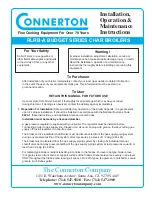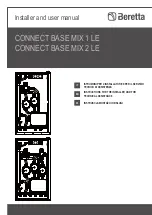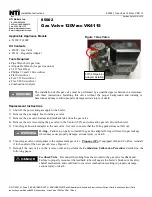
Page
19
of
30
IV. Operation
A. Wood Requirements
20% moisture content or lower is required for a GT boiler to achieve proper gasification.
Using unseasoned (“wet” or “green”) wood causes cooler burning temperatures preventing
gasification and severely reducing efficiency, causing the boiler to plug up with ash.
Only burn wood that has been cut, split and seasoned for 12-24 months, sheltered from rain and
snow. The wood should be split 6-8” in diameter and cut 12-16” for the fastest seasoning and
should be around 20% moisture content by weight before burning.
To test moisture content, use several pieces to get an average of a pile and first split the wood then
test using a moisture tester with pins suitable for wood (available from Nature’s Comfort or your
dealer), placing the pins in line with the wood grain. Testing the ends or outside of pieces will give
you a false, low reading.
Never burn driftwood, painted, stained or pressure treated wood. Do not burn trash, plastics,
gasoline, rubber, naphtha, household garbage, material treated with petroleum products (particle
board, railroad ties and pressure treated wood), leaves, paper products or cardboard.
The following are guidelines for wood:
Stack covered on rails off the ground,
stored outside of clearance area and away from front and
back of stove for space required for fueling, ash removal & other routine maintenance
operations
.
As rain and snow will greatly hamper seasoning, keep wood pile covered but open to the wind.
Wood will not dry out (season) properly until split.
Hardwoods burn longer than softwoods as they are denser and have more available BTU’s.
Larger pieces burn longer than smaller pieces but take longer to season properly.
Wood with higher moisture content wastes energy to dry out wood and produces increased
amounts of creosote which, when mixed with ash and heat is corrosive and will shorten the life of
the boiler.
Higher moisture content also cools the exhaust gases, possibly eliminating complete gasification
which severely reduces efficiency and will also clog the refractory with ash. If you see moisture
oozing from the ends of burning pieces, this points to improper seasoning.
Rotten, old wood burns rapidly and does not have enough fuel mass for decent burn times.
B. Starting A Fire
Do not use combustible fluids or chemicals. Turn on the front and rear switch to run the blower.
Starting over the holes in the floor, criss-cross a small pile of sticks or pieces of split kindling about
the size of a dinner plate on top of several crumbled newspaper pages and light with a torch or
match and slowly add larger kindling pieces. Once this is sufficiently ignited, add 2-4 logs and close
the fuel door. Wait for these pieces to sufficiently ignite before loading the firebox full.
Caution!
Follow procedures as outlined in “Loading Wood” (next section) for opening fuel door.
It can take up to 1-2 hours for the refractory channel to get hot enough for gasification to start and
the boiler to burn smokeless. There will also be a large amount of condensation created until the
water jacket comes up to temperature. This may drip from access doors and covers and will dry out
within 24 hours.
Summary of Contents for GT-6000
Page 16: ...Page 16 of 30 ...












































